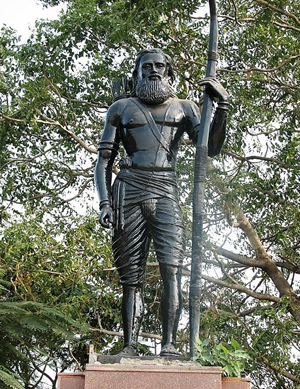Alluri Seetha Rama Raju
Alluri Seetha Rama Raju
Alluri Sitarama Raju was an Indian revolutionary involved in the Indian independence movement.
Birth and his childhood
Born on July 4, 1897, into a humble middle-class family in a small village near the Coastal city of Visakhapatnam, Rama Raju was strongly influenced by patriotic discourse quite early in his life. When a friend gave him a handful of badges with King George's picture on it, the 13-year-old Raju threw all but one. He pinned it up on his shirt and would say: "To wear them is to flaunt our servitude. But I pinned it on my shirt near my heart to remind all of you that a foreign ruler is crushing our lives.”
His contribution to freedom struggle and welfare of Adivasis
 Following the death of his father, his schooling got disrupted and he went on a pilgrimage and toured the Western, North-Western, North and North-eastern India during his teens. The social-economic conditions in the country under the British regime, particularly in the tribal areas, deeply moved him. During these journeys, he met revolutionaries in Chittagong (now in Bangladesh).
Following the death of his father, his schooling got disrupted and he went on a pilgrimage and toured the Western, North-Western, North and North-eastern India during his teens. The social-economic conditions in the country under the British regime, particularly in the tribal areas, deeply moved him. During these journeys, he met revolutionaries in Chittagong (now in Bangladesh).
Rama Raju made up his mind to build a movement against the British. He made Adivasi areas in the Eastern Ghats (the forest area along the Visakhapatnam and Godavari district) his home and decided to work for the Adivasis, who were living in abject poverty and being fleeced by police, forest and revenue officials, in 'Manyam' (forest area). He started working amongst them and helped them by educating them and providing medical help, using the vast knowledge he gained from his extensive travels. He decided to make this area the hub for his fight against the British.
He began to organise Adivasis against the atrocities by the police, the forest and revenue officials and extensively toured the 'Manyam' area. He told them that they were the sole owners of the forest produce and prepared them to fight against the oppressive Madras Forest Act, 1882. A slew of initial successes gave a lot of hope and confidence among the Adivasis and people in the surrounding villages and more and more of them began to rally behind Rama Raju.
As he organised them to defend their rights on the produce, he gained tremendous understanding of the terrain that had helped him in great deal in his future guerrilla war against the British forces. He would appear at one place this moment and disappear in moment to appear somewhere else in no time, giving sleepless nights to the British forces. Legends on his attacks and exploits on the police stations in the region have become part of the folklore. He built a strong team of followers from the area, who built a formidable army sporting traditional weapons like bow-and-arrow and spears and achieved spectacular successes against the British forces.
He learnt from the Adivasis, the time-tested methods of war and added his own tactics to put up a formidable fight against the British. For instance, his team used whistles and beatings of the drums to exchange messages amongst the revolutionaries. He soon realised that the traditional weaponry would be of no use against the heavily armed the British forces. He thought the best way is to snatch them from the enemy and launched attacks on police stations with a lightning speed.
The first of such attacks was made on Chintapalli police station in Visakhapatnam Agency area on August 22, 1922, with over 300 revolutionaries under the leadership of Raju taking part in it. Subsequently, similar attacks were made on Krishnadevi Peta police station and Raja Ommangi police station. They snatched weapons and armoury in all such attacks. A large contingent of Reserve Police personnel from Visakhapatnam, Rajahmundry, Parvatipuram and Koraput were rushed to these areas led by British officers. Two of the officers – Scot and Heiter were killed in battles with revolutionaries on September 24, 1922, and several others wounded.
All the attacks were concluded by a trademark letter signed by Raju himself, giving details of the booty in the station diary. Another hallmark of his attacks was that he would announce the date and time of the attack.
The Agency Commissioner J R Higgins had announced a prize of Rs 10,000 for Rama Raju's head and Rs 1,000 each on his lieutenants Gantam Dora and Mallu Dora . It deployed hundreds of soldiers from Malabar Special Police and the Assam Rifles, led by top British officers, to crush the movement. Officers like Sanders and Forbes were on the back foot several times as Raju dared them to stop him and his followers from carrying out certain attacks.
Unable to contain the ‘Manyam’ uprising, the British Government deputed T G Rutherford in April 1924 to quell the movement. After a relentless chase by British forces, Rama Raju was caught and martyred on May 7, 1924. His remains are buried at Krishnadevi Peta in Visakhapatnam.
He led the ill-fated “Rampa Rebellion” of 1922–24, during which a band of tribal leaders and other sympathizers fought against the British Raj. He was referred to as “Manyam Veerudu” (Hero of the Jungles) by the local people. Though his battle with the British lasted only for two years, he made an indelible mark in the history of the Indian Freedom Struggle and found a permanent place in the hearts of the countrymen.
Source : PIB
Last Modified : 8/27/2024
This topic provides information about Events that ...
Provides information about Unsung Flag Martyrs
Provides information about Baba Banda Singh Bahadu...
